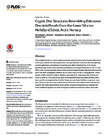Cryptic disc structures resembling Ediacaran discoidal fossils from the lower Silurian Hellefjord Schist, Arctic Norway
Citation
Kirkland CL, MacGabhann BA, Kirkland BL, Daly JS (2016) Cryptic Disc Structures Resembling Ediacaran Discoidal Fossils from the Lower Silurian Hellefjord Schist, Arctic Norway. PLoS ONE 11(10): e0164071. doi:10.1371/journal.pone.0164071

View/
Date
2016Author
MacGabhann, Breandán Anraoi
Kirkland, Christopher L.
Kirkland, Brian L.
Daly, Stephen
Peer Reviewed
YesMetadata
Show full item record
Kirkland CL, MacGabhann BA, Kirkland BL, Daly JS (2016) Cryptic Disc Structures Resembling Ediacaran Discoidal Fossils from the Lower Silurian Hellefjord Schist, Arctic Norway. PLoS ONE 11(10): e0164071. doi:10.1371/journal.pone.0164071
Abstract
The Hellefjord Schist, a volcaniclastic psammite-pelite formation in the Caledonides of Arctic Norway contains discoidal impressions and apparent tube casts that share morphological and taphonomic similarities to Neoproterozoic stem-holdfast forms. U-Pb zircon geochronology on the host metasediment indicates it was deposited between 437 ± 2 and 439 ± 3 Ma, but also indicates that an inferred basal conglomerate to this formation must be part of an older stratigraphic element, as it is cross-cut by a 546 ± 4 Ma pegmatite. These results confirm that the Hellefjord Schist is separated from underlying older Proterozoic rocks by a thrust. It has previously been argued that the Cambrian Substrate Revolution destroyed the ecological niches that the Neoproterozoic frond-holdfasts organisms occupied. However, the discovery of these fossils in Silurian rocks demonstrates that the environment and substrate must have been similar enough to Neoproterozoic settings that frond-holdfast bodyplans were still ecologically viable some hundred million years later.
Keywords
CrypticDisc
Structures
Resemblance
Ediacaran
Discoidal
Fossils
Lower Silurian Hellefjord Schist
Arctic Norway

